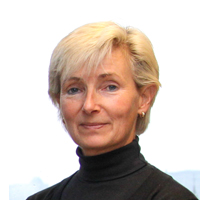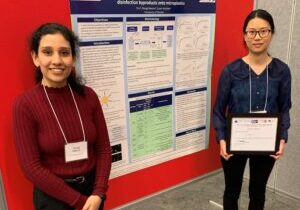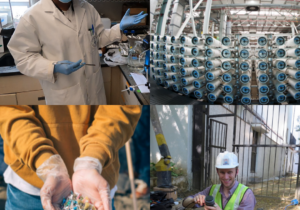
Susan Andrews
Professor
Department of Civil & Mineral Engineering
Email: susan.andrews@utoronto.ca
Office: GB319D
Tel: 416-946-0908
Drinking Water
Background
Professor Susan Andrews' research is concerned with the optimization of water treatment processes, especially in the area of drinking water disinfection. The balance between inactivating pathogens and minimizing the formation of chemical by-products is of particular concern, with a focus to evaluating a variety of disinfection technologies including using light (ultraviolet, solar) as an alternative to traditional chemical disinfectants (chlorine).
Environmental research in inherently interdisciplinary. Professor Andrews participates in projects that span the globe (North America, Europe, Singapore) and which often include participants from non-engineering fields. One perhaps more obvious example of this interaction is the relationship between optimizing drinking water disinfection and improvements to public health. Her research has been published in respected journals and presented by her or her students at national and international conferences.
Professor Andrews is currently a Program leader for the Canadian Water Network, and she has held leadership posts in several professional organizations (Chair, Ontario Water Works Association; Director, Walkerton Clean Water Centre). These interactions have helped to strengthen links between the academic and public sectors as well as foster interdisciplinary research interactions.
Publications
| Andrews, S.A., 2008. NDMA - A New DBP and a Kink in Sustainability Efforts. Presented and in the proceedings of the 58th Annual University of Kansas Environmental Engineering Conference, Lawrence, KS, February 6. |
|---|
| Amiri**, F. and S.A. Andrews, 2008. Development of a Size Exclusion Chromatography-Postcolumn Electrochemical Detection Method for the Analysis of Total Organic and Inorganic Chloramines. J. Chromatog. Sci., 15 pp, accepted February 2008. |
| Andrews, S.A., 2007. Nitrosamines and Challenges for Treatment. Proceedings, "Newest Generation of Emerging Contaminants" session at the American Water Works Association Annual Conference and Exposition, Toronto, ON, June, 2007. |
| G.A. Gagnon, H. Baribeau, S.O. Rutledge, R. Dumancic*, A. Oehmen, C. Chauret and S.A. Andrews, 2007. Disinfectant Efficacy in Distribution Systems: A Pilot-Scale Assessment. Journal of Water Supply: Research and Technology - AQUA, accepted December 2007. |
| Alam, M.Z.B., R. Cantwell, R. Hofmann, R.C. Andrews, J. Rand, G. Gagnon, M. VanderMarck, E. Moffat, and S.A. Andrews, 2007. Effect of ClO2 pre-treatment on subsequent water treatment processes. J. Environ. Eng., 31 pp, accepted with minor revisions May 2007. |
| Dumancic*, R. and S.A. Andrews, 2005. Organic Chloramine Formation in Model Distribution Systems. Proceedings, American Water Works Association Annual Conference and Exhibition, San Francisco, CA, June, CD ROM 9 pp. |
| Baribeau, H., G.A. Gagnon, Andrews, R.C., R. Hofmann, S.A. Andrews and C. Chauret, 2005. Efficacy of Disinfectant Residuals in Distribution Systems. Proceedings, AWWA Water Quality Technology Conference, Quebec City, PQ, Nov., CD ROM 26 pp. |
| Baribeau, H., N.L. Pozos, L.Boulos, G.F. Crozes, G.A. Gagnon, S. Rutledge, D. Skinner, Z. Hu, R. Hofmann, R.C. Andrews, L. Wojcicka, Z. Alam, C. Chauret, S.A. Andrews, R. Dumancic* and E. Warn, 2005. Impact of Changes in Distribution System Water Quality on Disinfection Efficiency. Final Report, AwwaRF/USEPA project 2771, AwwaRF and AWWA, Denver, CO, 278 pp. (full peer review). |
| Valentine R.L., Choi J., Chen Z., Barrett S.E., Hwang C., Guo Y. Wehner M., Fitzsimmons S., Andrews S.A., C.M. Brubacher* and K.D. Kohut*, 2005. Factors Affecting the Formation of NDMA in Water and Occurrence. Final Report, AwwaRF/ WERF project 2678, Denver, CO, 306 pp. (full peer review). |
| Linden, K.G., S.A. Andrews, K.Z. Atasi, M. Stefan, I.H. Suffet, 2004. Innovative UV Technologies to Oxidize Organic and Organoleptic Chemicals. Final Report for AwwaRF and USEPA project 2599, AwwaRF and AWWA, Denver, CO, 234 pp. (full peer review). |
| Liu**, W. and S.A. Andrews, 2003. Optimal Methods for Quenching H2O2 Residuals Prior to UFC Testing. Wat. Res., 37(15), 3697-3703. |
| Brubacher*, C.M., S.A. Andrews and A.G. Werker, 2003. NDMA Formation from Wastewater Treatment Processes for Water Reuse: Stage 1 Results. Proceedings, Special Topic Session, NDMA - the Latest, American Water Works Association Annual Conference and Exhibition, Anaheim, CA, June, CD ROM. |
| Barrett, S., C. Hwang, Y.C. Guo and S.A. Andrews, 2003. Occurrence of NDMA in Drinking Water: A North American Survey 2001-2002. Proceedings, American Water Works Association Annual Conference and Exhibition, Anaheim, CA, June, CD ROM. |
| Peldszus, S., P.M. Huck and S.A. Andrews, 1998. Quantitative Determination of Oxalate and Other Organic Acids in Drinking Water at Low µg/L Concentrations. J. Chromatog. A., 793, 198-203. |



